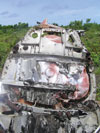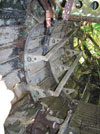 |
at the Old Colonia Airport, Yap State
Federated States of Micronesia
Site #3
Identification: Mitsubishi A6M5B Zero fighter based on: Outboard fuel tanks; fixed wing tips, no bulge under wing panel, large & small caliber fuselage guns.
Site #3 consists of one wing sitting on its right gear leg, connected with a small part of the fuselage in the cockpit area, and part of the other wing. 95% of the fuselage is missing, including the tail section and everything from the firewall forward. The left gear leg has been removed, unbolted, and the engine mounts have been cut to remove the complete engine package.
Fuselage: What is left of the fuselage exhibits considerable damage from shrapnel or small arms fire. Two different size ammunition chutes are still attached behind the firewall, but almost everything else is missing. Different caliber feed chutes for the fuselage machine guns help identify this as an A6M5B.
Wing: Spar caps are highly corroded, right wing outer panel has failed and is lying on the ground. Top skins on center section are in relatively good condition; some graffiti. What is left of the left wing is mangled from the gear outboard. Corrosion is significant inside the wings and on the lower surfaces.
Click on each photo below to open a full-sized image in a new window.
Site #3 Overview |
Site #3 showing engine mounts. |
Site #3: Shrapnel/small arms damage |
Site #3: Remnant
fuselage. |
Site #3: Ammunition feed chutes. |
Site #3: Corrosion on wing undersurface. |
Site #4
Identification: Mitsubishi G4M1 Model 11 “Betty” bomber, based on: bolt together tail/fuselage; tail cone, rear gun position: flat flanged frame w/downward view windows; round hatch, port side, within red insignia just aft of bolt together seam; tear drop shaped waist gun positions, P&S, Model 11 style; top gun position, Model 11 style; nose section: minimal glass fwd of windshield; props have spinners; 3 blade props; exhaust collector rings.
Site #4 is a Betty bomber blown apart by a bomb blast and possibly relocated by subsequent runway clearing. The tail section (Debris Field B) is sitting on the edge of a large bomb crater and the right wing is mostly buried in the edge of that crater.
The left wing, left engine, cockpit section and remainder of the fuselage are about twenty meters away (Debris Field A).
The tail section and right wing are likely sitting where they came to rest after the blast while the rest of the parts seem to have been consolidated close by. There are miscellaneous parts and a small tail section from a single engine plane (Zero?) mixed in with the Betty wreckage. Several other bomb craters are close by. The trail leading into the site has been marked with native plants and is maintained. Trees have been trimmed around this site to keep wreckage clear. Along this trail, 100m to the north is the wreckage of a Boeing 727-92C (Continental Air Micronesia Flight 614, N18479, which went off the runway on November 21, 1980).
Tail section (Debris Field B): The tail section is sitting on the edge of a large bomb crater, perhaps the one that destroyed the plane, though this feature may also reflect in part, or have been modified by, subsequent runway clearing and grading. Dirt is pushed up under the right side tilting it about twenty degrees to the west, away from the crater. It is largely complete from the bolt together seam aft. The right side of this section exhibits bomb blast damage from the direction of the crater.
The right side is buckled, shrapnel has come out the left side and the vertical stabilizer is bent to the left, away from the blast. The paint has deteriorated from the sun and elements, leaving an orange primer on about 50% of the structure. Exterior skins on top of the fuselage are in good condition while those on the sides and closer to the ground are more corroded. The left side horizontal stabilizer is highly corroded, and exhibits blue inner coating. The tail cone, gunner position, is completely intact; no Plexiglas in the openings. What is left of the corroded 20 mm. cannon is still in approximate position, though disattached. The right horizontal stabilizer is sticking up at about 20 degrees above horizontal and is highly corroded. Corrosion on the skins seems to develop on the inside and eat its way to the outside.
Right wing: The right wing appears to be about 90% buried in the west bank of the bomb crater, as presumably is the right engine. The wing root portion is exposed. Other bits are scattered around the crater, all highly corroded.
Left wing debris field A: The left wing and engine are likely located close to their original landing place after the bomb blast. Much of the other smaller debris in the area has been moved to this site. The wing is located roughly E-W and is resting right side up, with smaller components and debris piled on top. This section extends from the centerline of the fuselage out about 1m past the attachment point for the outer wing panel and is highly corroded.
Miscellaneous Debris: Pieces stacked on or lying around the wing include: corrugated floor panels, curved fairings, control surface pieces, hydraulic plumbing, oil coolers, exhaust components, pressure tanks (fire and/or oxygen), landing gear and wheel, pumps, wrapped wiring harness sections, wing tip, electrical components and switches as well as many other less identifiable components.
Engine: The left engine is sitting upright, spinner pointed toward the sky, just north of the left wing about two meters from its original mount. A three blade prop is still attached, one blade moderately bent and one severely curled under. The engine is a fourteen cylinder, two row radial. The cowl is still attached and may or may not have had one air intake. The area is mangled. The exhaust goes into a ring manifold. Everything is highly corroded.
Debris Field A: Miscellaneous parts between the left wing and cockpit area:
Tail section (Zero?), mangled and highly corroded.
Landing gear leg and wheel (Zero?)
Probable bomb rack
Interior floor section with attached seven valve fuel selector manifold
Small instrument panel section
Rectangular oil cooler
Blower wheel and gear case
2 folding seats
Top canopy forward section
Parts of another bomb rack
Portion of wing leading edge
Smaller engine (Zero?) cylinder head, broken
Radio components
Plumbing components
Nose section of fuselage: The nose section of fuselage extends from aft edge of rear window forward about 1 meter in front of windshield. It is rolled 30 degrees onto its port side and deformed. The pilot’s seat and the one directly behind are still attached. Gauges, yokes, one quadrant and many smaller items have been removed. The nose is from a variant (Model 11) with minimum Plexiglas and is heavily corroded.
Piles directly in front of and north of the nose: Directly in front of nose to the northwest are two large sections of center fuselage with port and starboard gun positions. A blower and accessory case are lying on the ground just to the west. To the north of the nose are the top and right side of the Betty with a small portion of the top gun position. Everything is highly corroded.
| Appendix p. 1 | Appendix p. 2 | Appendix p. 3 |
Appendix |
 |
Copyright 2021 by TIGHAR, a non-profit foundation. No portion of the TIGHAR Website may be reproduced by xerographic, photographic, digital or any other means for any purpose. No portion of the TIGHAR Website may be stored in a retrieval system, copied, transmitted or transferred in any form or by any means, whether electronic, mechanical, digital, photographic, magnetic or otherwise, for any purpose without the express, written permission of TIGHAR. All rights reserved. Contact us at: info@tighar.org • Phone: 610.467.1937 • JOIN NOW |


























